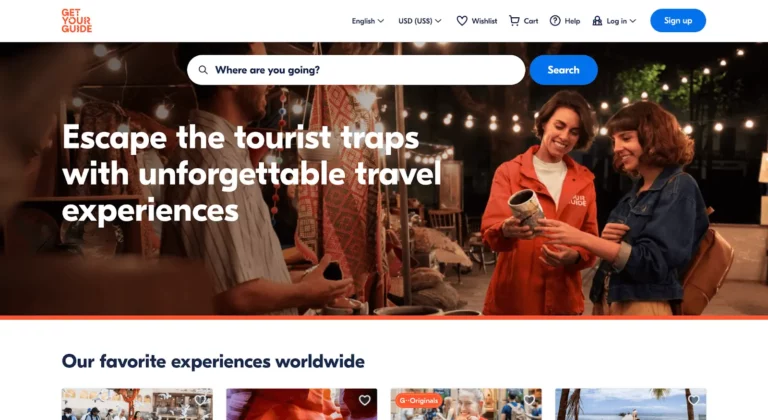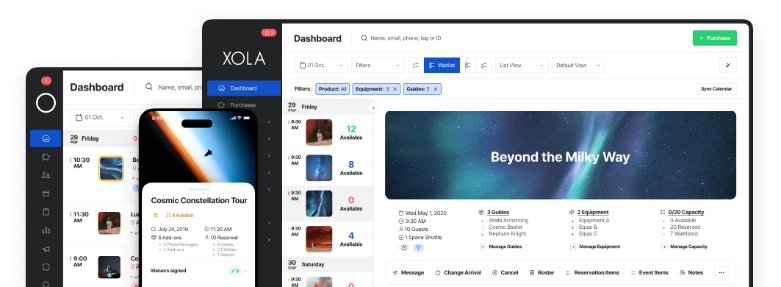
Considering that a single negative experience can turn away a longtime customer, tour and attraction operators should have a plan in place when an experience goes south.
In essence, guest service recovery is about going above and beyond to ensure that guests leave with a positive impression, even when things don’t go as planned. It involves actively listening to guests, taking ownership of the problem, and finding effective solutions.
In this post, you’ll learn how to approach guest recovery in a proactive manner, ensuring that you’re building a stronger relationship with your guests even when things don’t go as planned.
What is guest service recovery?
Guest service recovery is the process of taking proactive steps to rectify situations where guests are dissatisfied. Simply put, it’s about turning a negative situation into a positive one.
Imagine the following scenario: You’re running a helicopter tour and things are flying smoothly. But then the weather goes haywire, or a reservation slips through the cracks. Guests get upset. That’s when guest service recovery comes into play.
Rather than seeing these situations as setbacks, guest service recovery allows you to enhance customer satisfaction and loyalty. In other words, it’s not about aiming for perfection; it’s about how you respond when issues pop up.
When a business demonstrates its ability to make things right, it’s not just recuperating a lost customer, but also cultivating loyal guests.
What’s the difference between customer service recovery and guest service discovery?
Customer service recovery strategies are all about what happens after something goes wrong. A tour runs late. An exhibit underdelivers. A ticketing error throws off someone’s schedule. Recovery kicks in to make things right—through a genuine apology, thoughtful compensation, or simply solving the problem fast. This reactive approach plays a critical role in customer experience efforts because how you handle a misstep often matters more than the misstep itself. In fact, a well-handled recovery can become a strong predictor of customer loyalty.
But here’s the nuance: it’s not enough to fix problems after the fact. That’s where guest service discovery comes in.
Discovery is proactive. It’s about anticipating needs before guests ever have to ask. Think of it as quietly removing friction from the customer journey and replacing it with moments of delight. This approach looks at patterns, response rates, and the categories of customer expectations that aren’t always voiced but still shape how someone feels about your brand. The goal? An engaged customer who never has to escalate an issue because the experience already feels thoughtful, personal, and easy.
Both approaches are essential. Recovery repairs the relationship. Discovery strengthens it before there’s even a risk of damage. When combined, they create a loop where every resolved issue and every elevated touchpoint contributes to stronger word of mouth, better repeat visit rates, and a customer experience people want to talk about.
The best-run tours and attractions don’t treat these strategies as separate. They bake them into every part of the operation. That’s how they build durable, high-quality service that compounds over time.
Proactive vs. reactive service recovery
There are two fundamental approaches to successful guest service recovery: proactive and reactive.
Proactive service recovery refers to a preventative strategy. The goal is to assess guest challenges and customer experience issues before they become problems. This approach requires a deep understanding of your guests and the categories of customer expectations they bring with them. By analyzing feedback trends, cost per customer data, and customer satisfaction metrics across key touchpoints, teams can identify potential friction early. That might mean noticing a drop in response rates through your customer communication platforms, spotting repeated confusion about ticketing times, or realizing that a popular exhibit consistently runs behind schedule. With that insight, you can train staff accordingly, adjust signage, or tweak the booking flow to remove pain points before guests even notice them.
Reactive service recovery, on the other hand, kicks in after something goes wrong. Maybe a family shows up for a behind-the-scenes tour only to find out it was overbooked. They’re frustrated. The kids are disappointed. In this case, the goal is to acknowledge the bad customer experience, offer a sincere apology, provide immediate options like rescheduling or a complimentary add-on, and do whatever it takes to turn the situation around. This kind of recovery matters. A high percentage of customers say they’re willing to forgive a mistake if it’s handled well. And in some cases, that resolution can create even more satisfied customers than if things had gone smoothly in the first place. That’s the paradox: when reactive service is excellent, it can convert an upset guest into one of your happiest, most loyal fans.
But it’s rarely cheap. Reactive recovery often requires more staff time, more training, and more perks or discounts to smooth things over. It’s why proactive strategies—while not always perfect—tend to reduce overall cost per customer while creating consistently happy customers and better personal experiences across the board.
The most effective organizations know when to use both. They don’t just react to issues. They anticipate them. And they make service recovery a natural part of the customer journey, not just a last resort when things fall apart.
Why proactive service recovery is the preferred approach for forward-thinking tour operators and attractions
By taking steps to prevent problems before they occur, you can create a smoother, more enjoyable experience for your guests. There are many pros to taking a proactive approach to guest recovery, including:
- Enhanced guest satisfaction: Guests are now less likely to encounter problems, leading to higher overall satisfaction.
- Cost efficiency: Preventing issues saves both time and resources.
- Stronger guest relationships: When guests see that you’re committed to their well-being and enjoyment, it builds trust and loyalty. The result? Repeat business and positive word-of-mouth recommendations.
- Positive brand image: Businesses that tackle guest issues proactively are perceived as attentive, caring, and customer-focused.
A step-by-step customer service process for tours and attractions
Navigating customer complaints and service failures can be challenging, especially for large-volume tours and attractions. However, by implementing a structured approach to service recovery, you can turn a potentially negative experience into an opportunity to build customer loyalty and a stronger reputation. Here’s a comprehensive plan to guide you through the process.
1. Acknowledge the issue immediately
When faced with dissatisfied customers, don’t shy away from their concerns. Acknowledge the issue promptly and with genuine empathy. Quick acknowledgment demonstrates that you value their experience and respect their time and feelings.
Imagine a family arrives for a scheduled boat tour only to find it’s been overbooked. Rather than making excuses, the tour manager immediately approaches them, acknowledges the mistake, and expresses sincere regret for the inconvenience. This immediate response helps defuse anger and opens the door to resolution.
2. Get to the bottom of it
Don’t just treat the symptoms—identify the root cause of the bad experience. Was it a booking system failure, staff miscommunication, or a mismatch between customer expectations and what your service actually delivers?
For instance, if guests consistently complain about long wait times for a popular attraction, dig deeper. Is it understaffing during peak hours? Inefficient queue management? Or perhaps unclear messaging about expected wait times on your website? Finding the real cause helps in creating effective solutions and prevents similar issues from disappointing future customers.
3. Provide a realistic solution
Transparency is crucial when offering a resolution. Present a fair and feasible solution that aligns with the severity of the service failure—whether it’s a refund, a complimentary return visit, or a token of appreciation for their patience.
Consider a scenario where visitors to a wildlife sanctuary miss a scheduled feeding demonstration due to incorrect information from a staff member. Rather than simply apologizing, the manager offers them priority access to the next demonstration and complimentary refreshments while they wait. This thoughtful response acknowledges their disappointment while providing tangible compensation.
4. Make real changes
Empty promises only lead to repeated service failures and increasingly angry customers. Implement tangible changes that address the underlying issues. This might involve revising operational procedures, enhancing staff training, or investing in better technology.
For example, after receiving multiple formal complaints about guides who couldn’t answer specific historical questions during heritage tours, a company might develop a comprehensive training program and reference materials for their customer service reps and guides. When returning guests notice the improvement, their confidence in your commitment to excellence strengthens.
5. Follow through with a service recovery plan
Don’t consider the matter closed once the immediate issue is resolved. Develop a structured service recovery plan that includes follow-up communication to ensure customer satisfaction. This demonstrates that you value the relationship beyond the transaction.
When a ziplining company experiences equipment issues that cut a tour short, they don’t just offer refunds. Their service recovery plan includes personal calls from the manager the following day, priority rebooking, and a discount on their next visit. This comprehensive approach transforms disappointed visitors into advocates who appreciate the extra mile the company went to make things right.
6. Seek honest feedback and learn from it
After resolving the issue, actively solicit feedback about both the original guest experience and your handling of the problem. This information is invaluable for continuous improvement.
A museum might send a personalized email to visitors who experienced problems with their interactive exhibits, asking specific questions about their experience and how well the situation was addressed. This feedback loop often reveals blind spots in your customer service approach and helps refine your response to future issues.
7. Train your team to handle difficult situations
Equip your staff with the skills and authority to address problems as they arise. Sometimes, the difference between a customer who leaves satisfied despite problems and one who files a formal complaint comes down to how well your frontline team manages the situation.
Create scenarios during training where staff practice responding to common issues—from weather-related cancellations to facility problems. Role-playing how to handle situations with dissatisfied customers builds confidence and competence in real-world applications.
8. Turn detractors into advocates
The most powerful demonstration of excellent service recovery is converting unhappy customers into loyal ones. When handled properly, a service failure actually creates a stronger bond than if everything had gone perfectly.
Consider a family who arrives at a theme park to find several attractions closed for maintenance. The park manager personally greets them, explains the situation, provides fast passes for operating attractions, complimentary meal vouchers, and discounted tickets for a return visit. Months later, these guests become regular visitors who tell friends about how wonderfully the park handled their initially disappointing day.
By implementing this structured approach to service recovery, you create opportunities to exceed customer expectations even when things go wrong. Remember, it’s not the absence of problems that defines exceptional service—it’s how effectively you respond when issues inevitably arise. In the competitive landscape of tours and attractions, your response to service failures can become your most powerful differentiator and the foundation for lasting customer loyalty.
Customer service frameworks to transform guest experience
Beyond the step-by-step process outlined above, several proven frameworks can help your team navigate service failures and effectively implement your customer service recovery plan in a short period of time. These structured approaches can help turn frustrated customers who’ve had a poor experience into loyal customers and demonstrate what experts call the “service recovery paradox,” where effectively resolved problems actually create stronger loyalty than if no issue had occurred at all.
Consider incorporating these customer service strategies into your training program for new customer service agents:
- The HEART Framework: Hear, Empathize, Apologize, Respond, Thank
- The LAST Model: Listen, Apologize, Solve, Thank
- LEAP Method: Listen, Empathize, Apologize, Problem-solve
- The 5A Method: Acknowledge, Apologize, Alternative, Action, Assurance
- The SERVICE Recovery Model: Show concern, Empathize, Reassure, Value input, Inform, Compensate, Elevate
- The LEARN Approach: Listen, Empathize, Apologize, React, Notify
- The CARP System: Control, Acknowledge, Refocus, Problem-solve
The HEART principle for assisting unhappy customers
In particular, The “HEART” principle is a proven guest service recovery framework for effectively communicating with unhappy customers and turning their negative experiences into a more positive customer experience.
Each letter in “HEART” represents a key step in the process: Hear, Empathize, Apologize, Resolve, and Thank.
Hear
The first step is to actively listen to the customer to fully understand their concerns. Giving them your undivided attention will make them feel heard and valued.
- Give the guest your full attention: Eliminate distractions and focus solely on their feedback or issue.
- Avoid interruptions: Let the customer speak without interruption, allowing them to express their concerns without feeling rushed.
- Ask open-ended questions: Encourage the customer to elaborate on the situation by asking questions that require more than a simple “yes” or “no” response.
For example, a guest complains about a long wait time at an exhibit at your attraction. You, as an attraction operator, respond to them by thanking them for sharing their experience with you. Assure them that you fully understand their concerns. Follow up with: “Can you please tell me more about your wait time and how it affected your visit today?”
Empathize
When a guest tells you how they feel, you’ll acknowledge their emotions and make them feel like you’re on the same side.
- Express understanding: Use empathetic language to convey that you grasp the customer’s frustration or disappointment.
- Validate emotions: Let the customer know it’s okay to feel the way they do and that their feelings are important.
- Avoid blame or defensiveness: Even if the issue wasn’t your fault, focus on the customer’s emotions rather than assigning blame.
Let’s go back to the example we mentioned above: When you respond to your unhappy guest, they continue to express frustration about the long wait time at your exhibit.
An empathetic response might look something like this: “I completely understand how waiting longer than expected can be frustrating, and it’s not the experience we want our guests to have. I’m genuinely sorry for any inconvenience this has caused you.”
Apologize
Apologizing to your customers demonstrates that you’re willing to take responsibility for their negative experience, regardless of who or what caused it.
- Be sincere: A sincere apology shows a genuine desire to make things right.
- Avoid conditional language: Don’t undermine the apology with phrases like “if you were offended.”
- Express regret: Show genuine remorse for any dissatisfaction the customer experienced.
Following these tips, the apology might look something like this: “I want to sincerely apologize for the extended wait you experienced. That’s not the level of service we aim to provide, and I’m truly sorry for any frustration it caused.”
Resolve
The next stage is about taking concrete steps to solve the problem.
- Assess the situation: Understand the problem thoroughly and brainstorm possible solutions.
- Propose a solution: Share your plan of action with the guest.
- Follow through: Ensure that the solution is implemented promptly.
For example, to make amends, you might offer the guest a complimentary return ticket.
Thank you
“Thank you” represents the final step of the HEART principle. Here, you’ll express gratitude for your guest’s patience, feedback, and continued relationship with your business.
- Show appreciation: Thank the customer for bringing the issue to your attention and for allowing you to resolve it.
- Remind them of your commitment: Emphasize your dedication to providing excellent service in the future.
Here’s a look at what that might look like: “Thank you for allowing us to address your concerns today. We genuinely value your feedback, and we look forward to providing you with a much-improved experience in the future.”
5 best practices for solving issues quickly
The HEART principle can serve as the foundation of your guest recovery process. Now, let’s see how you and your staff can best put this into practice.
1. Inform your frontline staff
Make your frontline employees, such as tour guides or customer service representatives, aware of your guest recovery processes. They should also be given the authority and training to address common issues on the spot. That way your employees can often resolve problems more quickly without the need for escalation.
2. Establish clear communication channels
Have clear communication channels in place, both internally and externally. What do we mean by this? Internally, ensure that your staff knows how to reach out for assistance and who to ask for information. Externally, make sure customers know how to contact your business with their concerns, whether it’s by phone, email, or live chat.
3. Leverage technology
Invest in technology that can help streamline issue resolution. This might include customer relationship management (CRM) software to track and manage customer issues, or mobile apps that allow staff to access information efficiently. You might also leverage AI tools like ChatGPT, which can facilitate communication with guests.
For example, you can integrate the chatbot on your website and train it to answer frequently asked questions, like “How can I cancel” or “Where can I park?”
4. Create standard operating procedures
Having a documented guest recovery process in place can help staff address problems consistently and efficiently.
For example, if a customer complains about the wait time to a staff member standing at the entrance of an exhibition or ride, does that staff member know who to report the complaint to? The same goes for negative reviews. If a customer leaves a bad review, is your customer service team aware of the next steps to resolve the issue? SOPs should be easily accessible to all employees, such as outlined in an online document.
5. Gather and monitor customer feedback
Regularly ask for feedback from your guests. This can help you identify and address issues before they become a bigger problem. To do this, establish a system for collecting feedback after tours or attractions, such as NPS surveys or automated emails asking for reviews.
Make sure you’re checking and replying to online reviews and survey responses regularly.
***
Guest recovery is a process that can transform unhappy guests into loyal supporters of your brand. The HEART principle — Hear, Empathize, Apologize, Resolve, and Thank — provides a structured approach to navigating unpleasant situations.
Remember, proactive service recovery is the preferred strategy for forward-thinking operators. By preventing issues before they occur, you build stronger relationships with your guests and maintain a positive brand image.





